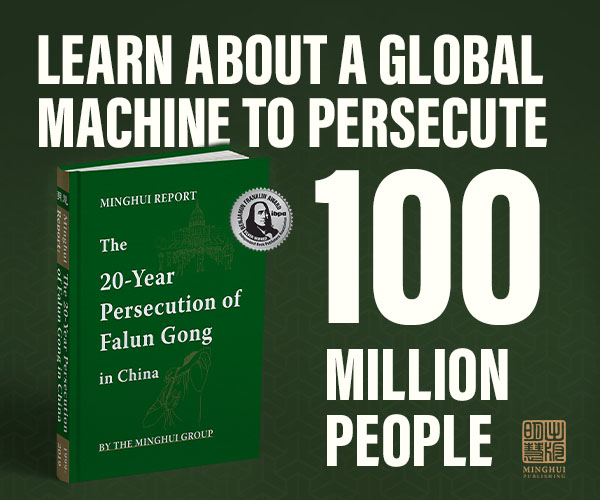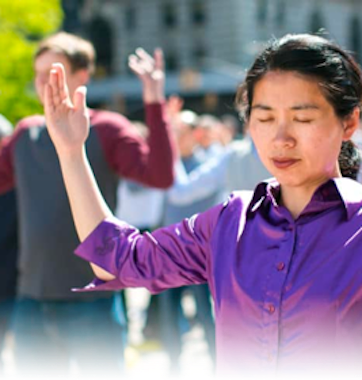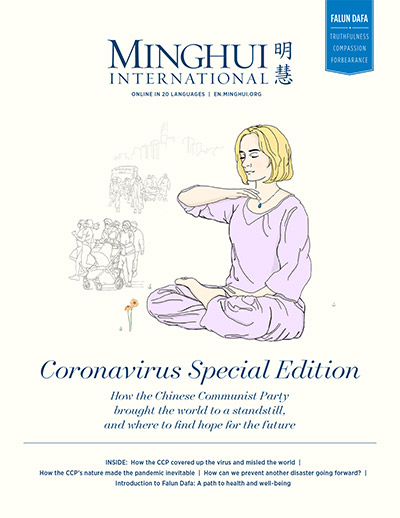(Minghui.org) Does the divine exist or not? Let us first look at two examples.
Surviving the Pandemic
Silke Wagner is a security inspector at Munich Airport in Germany. In mid-November 2021, she tested positive for the Delta variant of COVID-19. “The virus made me extremely weak. I had never had such a high fever before—41°C (106°F)—and my cough was worse than my husband and son’s, who were also infected. I tried to get up and walk around, only to fall down,” she recalled in a January 2022 article titled “On the Verge of Death, German Woman Recovers from Covid After Reciting Two Auspicious Phrases.”
“I asked my husband what to do and he suggested that I recite the words ‘Falun Dafa is good, Truthfulness-Compassion-Forbearance is good.’ I followed his advice and repeated the phrases over and over. I felt myself improving day by day,” Wagner continued.
Later on, her health gradually improved without taking any medication. In the end she fully recovered and returned to work. Surprised by this experience, she discarded her long-held atheism and has turned to Falun Dafa, becoming a practitioner like her husband Rainer Wagner.
Samuel Alvarado, a businessman from Mexico, had a similar experience. After being infected with COVID-19 in September 2020, he was taken to a hospital for emergency care. A CT scan showed his lungs were badly damaged and the inflammation left him hardly able to breathe. But with faith in Falun Dafa and by studying its teachings, he gradually recovered.
Many such examples have been published on Minghui.org. Once a person truly believes in Falun Dafa’s principles of Truthfulness-Compassion-Forbearance, adversity can be reversed. Many atheists and people who only believe in science often dismiss such miracles and try to find a scientific explanation, such as the patients’ condition was not severe to begin with, their immune system warded off the infection, and so on.
However, such an explanation didn’t make any sense to those who personally experienced such miraculous recoveries. Wagner and Alvarado both knew their full recovery was due solely to their faith in Falun Dafa. Wagner became a Falun Dafa practitioner and Alvarado, already a practitioner before he came down with the virus, became stronger in his faith. He said, “If you truly believe Falun Dafa is good, you’ll be saved.”
The fact that Wagner went from being an atheist to a Falun Dafa practitioner invalidates the argument many atheists make: “Where is the divine? I can’t see it, so there is no god.” Just because one cannot see gods doesn’t mean others cannot see them. Not seeing them is not proof that gods do not exist. When one experiences a divine miracle, his or her soul will be touched, and their perception of the existence of the divine will change fundamentally.
Numerous Examples
In fact, across cultures and throughout thousands of years of history and up to the present day, many people have seen the divine and experienced divine miracles. In addition to Wagner and Alvarado, many other Falun Dafa practitioners have seen their ailments disappear without any medical intervention, and even non-practitioners have regained their health by reciting “Falun Dafa is good, Truthfulness-Compassion-Forbearance is good,” something that modern science cannot explain.
In recent years, tears and even blood have been found on the statues of Jesus and the Virgin Mary. Scientists have verified that the composition of the tears and blood is similar to that of a living person, although they could not explain the source of the tears or blood. Some people believe they are hints that the divine beings are suffering for mankind and are giving us a warning.
Another example concerns a fire in China in February 2011. The fire almost destroyed the entire Wan Xin Hotel in Shenyang City, Liaoning Province, but a wooden Buddha statue inside the building remained intact. A month later, a magnitude-9.0 earthquake and tsunami hit Japan, but a Bodhisattva statue was unscathed in the ruins. Similarly, after Hurricane Sandy left New York City severely damaged in 2001, a statue of the Virgin Mary was one of the few structures that still stood above the debris. In addition, after the 2004 Indian Ocean earthquake and tsunami that claimed more than 200,000 lives, many Buddha statues were found intact.
Modern science has a hard time explaining these facts. But religious believers, who consider the disasters a result of mankind’s moral decline, were not surprised. “People are not living according to religious virtues," said Sumana, a monk in Sri Lanka. “Nature has punished them because they are not following the path of the Lord Buddha. The people have to learn their lesson.
“People don’t think of it as just a catastrophe but, rather, that the Gods are telling them that they need to improve their behavior,” he added. Another person commented, “Sri Lankans are becoming better people since the tsunamis.”
Scientific Perspectives
There are many unsolved puzzles in nature. For example, modern science believed the universe started with the Big Bang. To be more specific, the model says that our entire universe had to start from dense matter about 1.6X10-35 meters in size, at a temperature of about 1032 degrees, in about 10-43 seconds.
The conceit goes beyond that. “If the rate of expansion one second after the big bang had been smaller by even one part in a hundred thousand million million, the universe would have collapsed before it ever reached its present size,” wrote Stephen Hawking in The Illustrated Brief History of Time. Needless to say, one may need a religious faith to accept such precision.
Thomas Aquinas, an Italian theologian, wrote Summa Theologica to explain faith. He believed God to be the source of both the light of natural reason and the light of faith. In one of his articles, he proposed “Five Ways,” that is, five logical arguments for the existence of God. More specifically, they discuss the first mover, universal causation, contingency, degree, and the final cause or ends.
“It is certain, and evident to our senses,” he wrote, “that in the world some things are in motion. Now whatever is in motion is put in motion by another, for nothing can be in motion except it is in potentiality to that towards which it is in motion. Therefore it is necessary to arrive at a first mover, put in motion by no other; and this everyone understands to be God.”
Many scientists since Aquinas also believed in the divine. Issac Newton wrote: “And from true lordship it follows that the true God is living, intelligent, and powerful; from the other perfections, that he is supreme, or supremely perfect. He is eternal and infinite, omnipotent and omniscient; that is, he endures from eternity to eternity; and he is present from infinity to infinity; he rules all things, and he knows all things that happen or can happen. In want of other proofs, the thumb would convince me of the existence of a God.”
Quite a few other scientists were also believers, such as Nicolaus Copernicus, Galileo Galilei, Samuel F.B. Morse (inventor of the telegraph), Marie Curie, Alfred Nobel, Wilhelm Röntgen (first Nobel Prize winner), Guglielmo Marconi (inventor of radio communication), Edward Jenner (a pioneer in vaccines), the Wright brothers, Wernher von Braun (a pioneer in rocket and space technology), Francis Bacon, Max Planck (discoverer of quantum mechanics), Jean-Henri Fabre (renowned entomologist), and Ivan Pavlov.
Albert Einstein, one of the greatest scientists of all time, agreed. He wrote, “I want to know how God created this world. I am not interested in this or that phenomenon, in the spectrum of this or that element. I want to know his thoughts. The rest are details. I see a pattern, but my imagination cannot picture the maker of that pattern. I see a clock, but I cannot envision the clockmaker. The human mind is unable to conceive of the four dimensions, so how can it conceive of a God, before whom a thousand years and a thousand dimensions are as one?”
Should we ignore the existence of the divine? Probably not. After all, if we do not know where we came from, it would be difficult to return to where we belong.
Views expressed in this article represent the author's own opinions or understandings. All content published on this website are copyrighted by Minghui.org. Minghui will produce compilations of its online content regularly and on special occasions.
Category: Perspective










